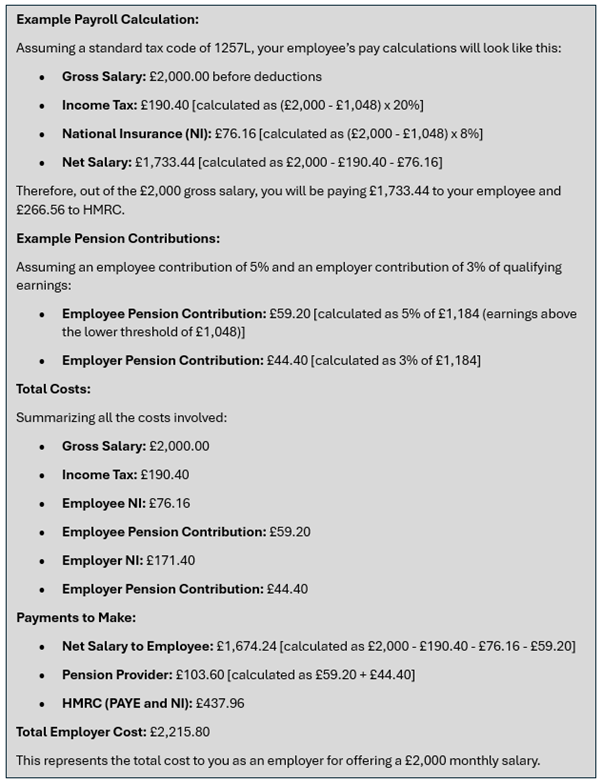It's exciting......
So, you're on the brink of expanding your business by hiring your very first employee. It's a thrilling milestone, no doubt about it.
But as you gear up to welcome a new member to your team, there's something important you need to wrap your head around: Payroll and PAYE costs. Yep, it's time to roll up those sleeves and dive into the financial nitty-gritty.
Let's talk numbers for a sec. When you hire an employee, it's not just about their salary. There's a few other costs and regulations to consider too.
Information you need when hiring your first employee
Hiring your first employee is a significant milestone for your business, and it's essential to gather the right information to ensure a smooth process. Here's a comprehensive list of what you'll need to get started:
1. Legal and Regulatory Information:
Employer Registration: Before you hire your first employee, you need to register as an employer with HM Revenue and Customs (HMRC). This process is typically done online and will provide you with a PAYE reference number.
Employment Contracts: Draft a written contract for your employee, outlining their job role, responsibilities, working hours, salary, benefits, and other terms of employment. Ensure it complies with UK employment law.
Right to Work: Verify that your prospective employee has the legal right to work in the UK. You will need to check and keep copies of relevant documents, such as a passport or visa.
2. Employee Information:
Personal Details: Collect your employee's full name, address, date of birth, and National Insurance number. This information is crucial for payroll and tax purposes.
Bank Details: Obtain your employee's bank account details to ensure their salary can be paid directly into their account.
P45 Form: If your employee has had a previous job, request their P45 form from them. This document provides details of their previous earnings and tax paid in the current tax year, which is essential for setting up PAYE correctly.
3. Payroll Setup:
Payroll Software: Choose and set up a payroll software system to manage your employee's salary, deductions, and tax contributions. Many payroll software options are HMRC-approved and can simplify the process of calculating and reporting PAYE.
PAYE System: Register for PAYE and familiarise yourself with how to operate the system. PAYE ensures that Income Tax and National Insurance contributions are deducted from your employee's salary and paid to HMRC.
4. Understanding Payroll and PAYE Costs:
Gross Salary vs. Net Salary: Understand the difference between gross salary (the total salary before deductions) and net salary (the take-home pay after deductions). This will help you accurately budget for payroll expenses.
Income Tax and National Insurance Contributions: Learn how to calculate Income Tax and National Insurance contributions for your employee. HMRC provides calculators and tools to assist with this.
Pension Contributions: If you offer a workplace pension scheme, ensure you understand the requirements for employer and employee contributions. Automatic enrolment may apply depending on the employee's earnings and age.
5. Workplace Policies and Procedures:
Health and Safety: Ensure your workplace complies with health and safety regulations. This includes conducting risk assessments and providing necessary training and equipment.
Employee Handbook: Develop an employee handbook outlining your company's policies on issues such as sick leave, holiday entitlement, disciplinary procedures, and grievance processes.
Getting Started
Plan Your Budget:
Calculate the total cost of hiring an employee, including salary, National Insurance, pension contributions, and any other benefits.
Ensure you have a sufficient budget to cover these costs on an ongoing basis.
Register as an Employer:
Visit the HMRC website to register as an employer and set up PAYE. This will involve obtaining an employer PAYE reference number.
Choose Payroll Software:
Select a payroll software that suits your business needs. Look for features such as automated tax calculations, payslip generation, and HMRC reporting capabilities.
Draft Employment Contracts:
Create a comprehensive employment contract for your new hire. Consider seeking legal advice to ensure the contract complies with employment laws and regulations.
Onboard Your Employee:
Once your new hire starts, provide them with a thorough onboarding process. This includes introducing them to the team, providing necessary training, and familiarising them with workplace policies and procedures.
Stay Informed:
Keep yourself updated on any changes to employment laws, tax rates, and payroll regulations. Subscribing to HMRC updates and joining relevant business networks can be beneficial.
By gathering the necessary information and following these steps, you'll be well-prepared to hire your first employee and set them up for success. Remember, taking the time to understand payroll and PAYE processes will help you avoid common pitfalls and ensure a smooth transition into becoming an employer.
Understanding the National Minimum Wage
When hiring your first employee, it’s essential to ensure that their salary complies with the National Minimum Wage (NMW) regulations set by the UK government. The NMW is the minimum pay per hour that almost all workers are entitled to by law, and it varies based on age and employment status.
Current NMW Rates (as of April 2024):
21 and over (National Living Wage): £11.44 per hour
18 to 20: £8.60 per hour
Under 18: £6.40 per hour
Apprentice: £6.40 per hour
Key Points to Remember:
Regular Review: The NMW rates are reviewed annually by the government. Ensure you stay updated with the latest rates to remain compliant.
Working Hours: The NMW applies to all hours worked, including overtime, training, travel time (if it is part of the job), and time spent on call.
Deductions: Certain deductions (e.g., for uniforms or tools) cannot bring an employee's pay below the NMW.
Steps to Ensure Compliance:
Calculate Hourly Pay: Divide the total pay by the number of hours worked to ensure it meets or exceeds the NMW.
Record Keeping: Maintain accurate records of employee hours and pay rates. This is crucial for demonstrating compliance in case of an audit.
Stay Informed: Regularly check for updates on the NMW rates and regulations from the official GOV.UK website.
Example: If you hire an employee aged 21 and offer them a monthly salary of £2,000, their hourly rate must be checked against the NMW. Assuming a 40-hour workweek:
Hourly Rate Calculation:
Monthly Salary: £2,000
Weekly Hours: 40
Weeks per Month: Approximately 4.33 (52 weeks in a year / 12 months)
Hourly Rate: £2,000 / (40 x 4.33) ≈ £11.54
In this case, the hourly rate of £11.54 is above the National Living Wage of £11.44, so you are compliant.
An alternative way of calculating monthly pay is working from the NMW upwards, so if you have an employee on the minimum wage, you can use the following calculation:
Monthly Pay Calculation:
Hourly Rate: £11.44
Actual working hours a week: 40
Weeks per year: 52.146
Annual pay: 52.146 x (£11.44 x 40) = £23862.01
Divide annual pay by 12 months to equal £1988.50 per month
This method ensures that you hourly rate correctly divides into a 12 month period and would assume a minimum of 28 days paid holiday given per year.
Ensuring compliance with the NMW is not just about avoiding legal penalties; it’s also about treating your employees fairly and fostering a positive work environment.
Calculating Holiday Pay
In addition to the NMW, you must also comply with UK regulations regarding holiday pay. Employees are entitled to a minimum amount of paid holiday, and it’s crucial to understand how to calculate this accurately.
Holiday Entitlement:
Employees are entitled to 5.6 weeks of paid holiday per year. For a full-time employee working five days a week, this equates to 28 days, including public holidays.
Calculating Holiday Pay:
Full-Time Employees: For employees working regular hours, holiday pay is straightforward. For example, if an employee earns £2,000 per month, their daily rate of pay would be £2,000 / 21.67 (average working days per month) ≈ £92.31.
Part-Time Employees: For part-time employees or those with irregular hours, holiday pay is calculated based on their average weekly earnings over the previous 52 weeks.
Example Calculation for Full-Time Employee:
If an employee takes one week of holiday (5 days), their holiday pay would be 5 x £92.31 = £461.55.
Example Calculation for Part-Time Employee:
If a part-time employee worked different hours each week, calculate their average weekly pay over the last 52 weeks and then pro-rate this amount based on the number of holiday days taken.
Record Keeping:
Keep accurate records of the holidays taken and the holiday pay calculated to ensure compliance with regulations and to resolve any potential disputes.
Key Points:
Public Holidays: You can include public holidays as part of the 28 days, but if you offer more, ensure this is reflected in the employment contract.
Carry Over: Some holiday entitlement can be carried over to the next year if mutually agreed upon, but at least four weeks must be taken each year.
Understanding and correctly calculating holiday pay ensures that you meet legal requirements and maintain a satisfied and motivated workforce.
Important note on holiday pay where you have ‘part year’ workers, such as those working in the education sector or agriculture. The calculation of holiday pay can be a little more complex, you should obtain advice regarding these individual circumstances. However, do remember that all employees are entitled to 28 days leave as a minimum. Pro-rating entitlement is likely to be unlawful and incorrect holiday calculations may result in a breach of minimum wage regulations.
Understanding UK Payroll and PAYE Costs
Once you’ve decided on a salary for your new employee, you'll need to ensure it meets the national minimum wage and holiday pay regulations. Here are some key factors to consider:
1. Salary and Payment Frequency:
Salary Calculation: Decide whether the pay will be a fixed salary paid in equal amounts throughout the year or based on hours worked each period.
Payment Frequency: Determine how often you will pay your employee. Many companies pay monthly, but some opt for weekly, fortnightly, or four-weekly payroll.
2. Employer's National Insurance:
On top of the employee’s deductions, you may also be liable for Employer’s National Insurance contributions. Many small businesses are eligible for relief subject to certain conditions, such as the Employment Allowance, which can provide up to £5,000 relief on Employer's National Insurance per year.
However, the relief cannot be claimed if:
You have only one employee paid above the Secondary Threshold of £9,100.
The employee is also a director of the company.
Where applicable, Employer’s National Insurance is an additional cost to the business.
3. Pension Contributions:
As an employer, you are also required to auto-enrol eligible employees into a pension scheme. Your automatic enrolment duties start when you employ your first member of staff. Here’s what you need to do:
Choose a Pension Scheme: As soon as possible after deciding to employ someone.
Work Out Who to Enrol: Assess each employee’s eligibility based on their earnings and age.
Communicate with Your Employee: Inform them about their enrolment within six weeks of their start date.
Declare Compliance: Report to The Pensions Regulator within five months of your first employee’s start date.
Using a workplace pension scheme, such as NEST, simplifies the process.
4. Payroll Breakdown Example:
For the purposes of this article, let's assume an annual salary of £24,000, paid monthly. This results in a gross salary of £2,000 per month.
Your employee won't receive the full £2,000 due to deductions for Income Tax and National Insurance. As the employer, you are responsible for deducting these amounts and paying them to HMRC.
By understanding these costs and the necessary steps, you can budget effectively and ensure compliance with UK payroll regulations.
It's OK to Feel Overwhelmed
Hiring your first employee is a significant milestone and can feel overwhelming with all the new responsibilities and information to process. Here are some tips to help you manage and stay on top of things:
1. Take It Step by Step:
Break down the process into manageable steps. Focus on completing one task at a time, such as registering as an employer, setting up payroll, and drafting employment contracts. This approach can make the entire process seem less daunting.
2. Seek Professional Help:
Don't hesitate to seek professional help. Accountants, payroll service providers, and HR consultants can offer valuable assistance and ensure that you're compliant with all legal and regulatory requirements.
3. Use Technology to Your Advantage:
Invest in reliable payroll software. Many payroll systems are designed to handle the complexities of PAYE, National Insurance, and pension contributions automatically. They also help you generate payslips and report to HMRC, saving you time and reducing errors.
4. Educate Yourself:
Take the time to educate yourself about the basics of payroll, PAYE, and employment law. HMRC offers a wealth of resources, including guides, webinars, and calculators, to help you understand your obligations as an employer.
5. Stay Organized:
Keep all your employee records, contracts, and payroll information well-organized. Maintaining good records will help you stay compliant and make it easier to manage your payroll.
6. Network and Connect:
Join local business groups or online forums where you can connect with other small business owners. Sharing experiences and advice can be incredibly reassuring and provide practical insights.
7. Plan for Contingencies:
Budgeting is crucial. Ensure you have a financial cushion to cover unexpected expenses or delays in payments. This will give you peace of mind and help you manage cash flow effectively.
8. Communicate Clearly:
Keep open lines of communication with your employee. Clearly explain their pay structure, benefits, and any deductions. Transparency helps build trust and reduces the likelihood of misunderstandings.
9. Continuous Improvement:
Regularly review and refine your payroll processes. As your business grows, your needs may change, and staying proactive will help you adapt smoothly.
10. Don't Be Afraid to Ask for Help:
If you're feeling overwhelmed, don't hesitate to ask for help. There are numerous resources available, from government websites to professional advisors. Seeking help early can prevent small issues from becoming big problems.
We're here to help!
Taking on your first employee is a big step, and it’s natural to feel a bit overwhelmed. However, by gathering the right information, planning carefully, and seeking support when needed, you can successfully navigate this process. Remember, you don’t have to do it alone. Our team is here to help you every step of the way.
Ready to get started? Book a payroll discovery call with us today, and let’s ensure your business is set up for success with your first hire. Use this link to pick a time


